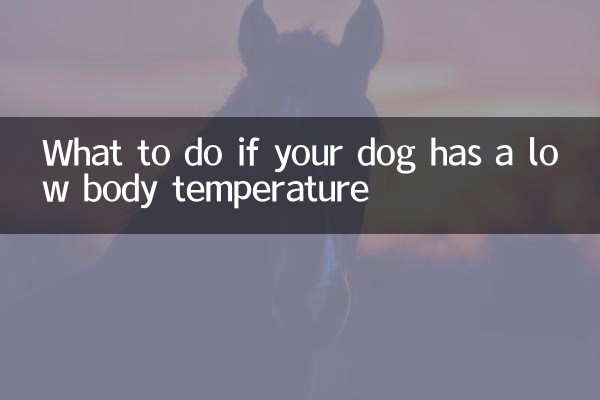What to do if your dog has a low body temperature
Recently, pet health issues have become one of the hot topics, especially the discussion about abnormal body temperature in dogs. Many pet owners ask the question “What to do if your dog has a low body temperature?” on social media and forums. This article will combine the hot content from the entire Internet in the past 10 days to provide you with detailed answers to the causes, symptoms and countermeasures of hypothermia in dogs, and provide structured data for reference.
1. Causes of low body temperature in dogs

Hypothermia (hypothermia) in dogs can be caused by a variety of factors. Here are some common causes:
| Reason | Description |
|---|---|
| Ambient temperature is too low | Prolonged exposure to cold conditions, especially in small or short-haired dogs |
| disease or infection | Such as hypoglycemia, hypothyroidism, sepsis, etc. |
| age factor | Puppies or older dogs have poorer body temperature regulation ability |
| anesthesia or surgery | Hypothermia may occur during postoperative recovery period |
2. Symptoms of hypothermia in dogs
The following are common symptoms of hypothermia in dogs that pet owners need to pay close attention to:
| Symptoms | Severity |
|---|---|
| shivering or trembling | Mild |
| Drowsiness or weakness | Moderate |
| slow breathing | Moderate |
| dilated pupils | Severe |
| coma | Severe |
3. How to measure a dog’s temperature
Correctly measuring body temperature is a key step in determining whether your dog is hypothermic:
| method | normal body temperature range | Things to note |
|---|---|---|
| Rectal temperature measurement | 38°C - 39°C | Use a pet-specific thermometer with gentle movements |
| Ear temperature measurement | 37.5°C - 39°C | Requires use of infrared ear thermometer |
4. Emergency measures for dogs with hypothermia
If your dog’s body temperature is found to be below 37°C, you need to take the following measures immediately:
| steps | Operating Instructions |
|---|---|
| keep warm | Wrap your dog in a blanket or use a hot water bottle (pay attention to the temperature) |
| Environmental warming | Adjust room temperature to around 25°C |
| replenish energy | Feed warm glucose water or high-energy food |
| Send to hospital for treatment | If your body temperature is below 35°C or your symptoms are severe, seek medical attention immediately |
5. Measures to prevent hypothermia in dogs
Prevention is better than cure, so here are some tips for protecting your dog from hypothermia:
| measures | Specific methods |
|---|---|
| Keep warm in winter | Prepare warm clothes and a kennel for your dog |
| diet modification | Appropriately increase high-calorie foods in winter |
| Regular physical examination | Pay special attention to the health of older dogs and puppies |
| avoid moisture | Keep your dog’s living environment dry |
6. When Do You Need Medical Treatment?
The following conditions indicate that your dog needs immediate medical attention:
| situation | Description |
|---|---|
| Body temperature consistently below 36°C | may be life threatening |
| accompanied by vomiting or diarrhea | May be a sign of serious illness |
| Confusion or coma | Urgent need for professional treatment |
7. Recent hot topics related to
According to the data analysis of the entire network in the past 10 days, the following are hot topics related to dog health:
| topic | Discussion popularity |
|---|---|
| Tips for keeping pets warm in winter | high |
| Prevention of common dog diseases | Middle to high |
| Pet first aid knowledge | in |
| Senior Dog Care | in |
Summary
Low body temperature in dogs is a health problem that requires attention, and pet owners should master basic judgment and handling methods. Through the structured data and detailed instructions provided in this article, I hope it will help you take better care of your dog. Remember, prevention and early intervention are key, and it is important to seek professional veterinary help promptly when the situation is serious.
Final reminder: Each dog’s situation may be different. The content of this article is for reference only. Please follow the veterinarian’s recommendations for specific treatment.

check the details

check the details